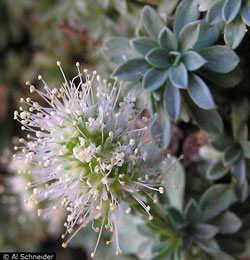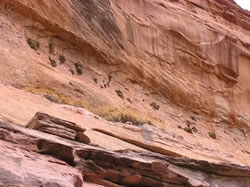Plant of the Week
 Petrophytum caespitosum range map. USDA PLANTS Database.
Petrophytum caespitosum range map. USDA PLANTS Database.
 Petrophytum caespitosum with dried, brown flower heads from the previous year, Colorado. Photo © Al Schneider.
Petrophytum caespitosum with dried, brown flower heads from the previous year, Colorado. Photo © Al Schneider.
 Close-up of the white flowers of Petrophytum caespitosum showing the elongated stamens, Colorado. Photo © Al Schneider.
Close-up of the white flowers of Petrophytum caespitosum showing the elongated stamens, Colorado. Photo © Al Schneider.
 White flower heads emerging from densely matted silvery-gray leaves of Petrophytum caespitosum, Colorado. Photo © Al Schneider.
White flower heads emerging from densely matted silvery-gray leaves of Petrophytum caespitosum, Colorado. Photo © Al Schneider.
 Petrophytum caespitosum in habit. Photo © Gary Monroe.
Petrophytum caespitosum in habit. Photo © Gary Monroe.
 Typical cliff-face habitat where Petrophytum caespitosum may be observed. Photo © Al Schneider.
Typical cliff-face habitat where Petrophytum caespitosum may be observed. Photo © Al Schneider.
Rock Spiraea (Petrophytum caespitosum)
By Walter Fertig
If you want to see rock spiraea (Petrophytum caespitosum) in the western United States, you need to find some rocks. Preferably you would want limestone, dolomite, or limey sandstone, and ideally the rock would be solid and cliff-forming. In these settings, you might be fortunate enough to encounter rock spiraea growing in tight mats of short dense leaves that cover the rock surface like skin. These mats can be so thick that they will hold together even if the rock below gives way. It is not uncommon to find a live plant dangling upside from a cliff face, held by its stout taproot. The plant’s preference for stony substrates is captured in its Latin name, literally translated as rock (petro) plant (phytum, or sometimes spelled phyton). Rock spiraea is the most widespread of the 3-4 species of Petrophytum native to western North America. This member of the Rose family (Rosaceae) ranges from Oregon to Montana and south to California, Texas, and northern Mexico. Related species are much less widespread, being restricted to Washington or California. The dense spikes of white, bowl-shaped flowers with long stamens superficially resemble those of Spiraea, a related genus of woody shrubs. Petrophytum differs from Spiraea in its matted growth form and in having narrowly spoon-shaped, silky-hairy leaves without marginal teeth.
In southern Utah, rock spiraea can be found on sandstone bedrock or on rock walls associated with hanging gardens. Rarely, the species also occurs on granitic cliff faces in Montana and elsewhere. The dried flower spikes persist for many months after flowering and are often more obvious than the flowers themselves. Flowering occurs in late summer or early fall, providing relatively little time for the many-seeded, dry follicle fruits to ripen before the onset of winter

